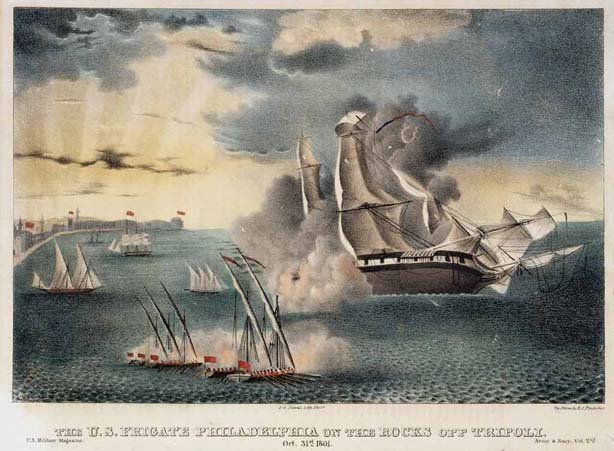To the Shores of Tripoli: The Marines’ Daring Raid Against Barbary Pirates

The Battle of Derna is where US Marines gained their nickname "Leathernecks." Composite by Coffee or Die Magazine.
On April 27, 1805, Marine Lt. Presley O’Bannon led a handful of Marines on a daring raid against a Libyan sea fortress held by Barbary pirates. The Marines were ultimately victorious, and when O’Bannon hoisted the 15 stars and 15 stripes of the star-spangled banner over the occupied fort, it marked the first time the American flag was raised in victory on foreign soil.
The monumental achievement occurred during the Battle of Derna in the First Barbary War. The famed raid has since been immortalized in Marine Corps lore in the form of the iconic first lines of the Marines’ Hymn: “From the Halls of Montezuma to the shores of Tripoli, we fight our country’s battles in the air, on land, and sea.”
The First Barbary War, also known as the Tripolitan War, began in 1801 when President Thomas Jefferson ordered the US Navy and US Marine Corps to regain control of the Mediterranean.
According to the US Marine Corps, “pirates from the four Barbary States of Morocco, Algeria, Tunisia, and Libya continuously raided US ships, stealing their cargo and valuables, capturing their crew to ransom them back to the United States, and charging fees for safety in the Mediterranean.”

Yusuf Karamanli, the reigning pasha of Tripoli, ordered the flagstaff cut down in front of the US Consulate in May 1801; the action constituted a declaration of war. In response, Jefferson increased the number of US Navy vessels and US Marines in the region. The US military engaged in minor confrontations with the Barbary Pirates for two years before the conflict came to a head.
In 1803, the USS Philadelphia ran aground off the shore of Tripoli during a storm, and pirates imprisoned the ship’s crew. The US bombarded Tripoli with their naval vessels and offered a hefty ransom payment in exchange for the Americans. When negotiations failed, US naval agent William Eaton suggested allying with Hamet Karamanli, the older brother of the pasha.
“As a result of these negotiations, Eaton, assisted by US Navy Lieutenant John H. Dent (later replaced by Midshipman George Mann), was able to assemble a mixed force of some 400 men, composed of 38 Greek mercenaries, 25 mostly European artillerists, 90 men serving under Hamet Karamanli directly, 190 camels and their drivers, a small force of Arab cavalry, and eight US Marines commanded by First Lieutenant Presley Neville O’Bannon,” a Naval History and Heritage Command article reads.
At the beginning of March 1805, the motley crew traveled overland some 500 miles over a span of six weeks from Alexandria, Egypt, across the North African desert to their objective in Derna: the easternmost town under Tripoli’s control. The troops overcame mutiny, hunger, thirst, and religious tension before arriving in Derna on April 25, 1805.
Eaton prepared a letter calling for the surrender of the stronghold despite, being outnumbered by 945 cavalry troops and 1,250 infantry soldiers defending the harbor fortress. Governor Mustapha Bey’s reply to Eaton’s offer allegedly said, “My head or yours.”
While the USS Nautilus, USS Hornet, and USS Argus launched a barrage of cannon fire from the sea, O’Bannon and his Marines and mercenaries endured enemy musketry to seize enemy batteries.

“After only 45 minutes, the enemy artillery was neutralized, and after two-and-a-half hours, Derna had been taken,” according to the US Marine Corps.
Two Americans were killed in action and three more were wounded, while the number of casualties of the Tripolitians remains unknown. Although Yusef sent reinforcements, the city of Derna fell to the Americans. Eaton planned to continue fighting to capture more land across Tripoli. Instead, Eaton’s orders demanded his return to Egypt following the signing of a treaty to end the war.
Ultimately, the Battle of Derna marked the beginning of several Marine Corps traditions. It proved the Marine Corps was an expeditionary force capable of rapidly deploying anywhere in the world. The Marines also acquired their “Leatherneck” nickname after Barbary pirates discovered the Marines’ high leather collars added a layer of protection against sabers. In addition, O’Bannon and Mann acquired a souvenir from the war — the so-called Mameluke Sword — for their tenacity in battle. The memento later served as the model for the US Marine Corps officer sword. Mann’s sword is currently on display in the US Naval Academy Museum.
Read Next:

Matt Fratus is a history staff writer for Coffee or Die. He prides himself on uncovering the most fascinating tales of history by sharing them through any means of engaging storytelling. He writes for his micro-blog @LateNightHistory on Instagram, where he shares the story behind the image. He is also the host of the Late Night History podcast. When not writing about history, Matt enjoys volunteering for One More Wave and rooting for Boston sports teams.
BRCC and Bad Moon Print Press team up for an exclusive, limited-edition T-shirt design!
BRCC partners with Team Room Design for an exclusive T-shirt release!
Thirty Seconds Out has partnered with BRCC for an exclusive shirt design invoking the God of Winter.
Lucas O'Hara of Grizzly Forge has teamed up with BRCC for a badass, exclusive Shirt Club T-shirt design featuring his most popular knife and tiomahawk.
Coffee or Die sits down with one of the graphic designers behind Black Rifle Coffee's signature look and vibe.
Biden will award the Medal of Honor to a Vietnam War Army helicopter pilot who risked his life to save a reconnaissance team from almost certain death.
Ever wonder how much Jack Mandaville would f*ck sh*t up if he went back in time? The American Revolution didn't even see him coming.
A nearly 200-year-old West Point time capsule that at first appeared to yield little more than dust contains hidden treasure, the US Military Academy said.












